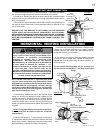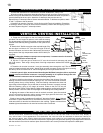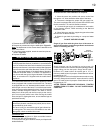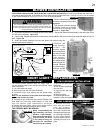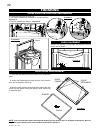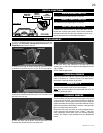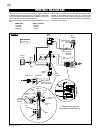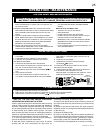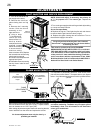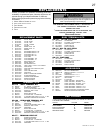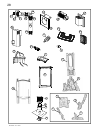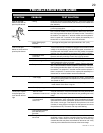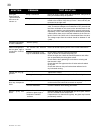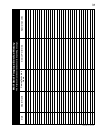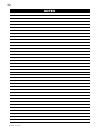
26
W415-0607 / A / 01.18.08
NOTE: Check and adjust, if necessary, the primary air
to
7
/
16
” for propane and
1
/
4
” for natural gas. Replace the
screws.
7. Turn on the gas supply and check for gas leaks by brushing
on a soap and water solution.
Do not use open fl ame.
8. Replace the log set. Then light the pilot and main burner
to ensure that the gas lines have been purged.
9. Replace the glass viewing door and cast front. Turn on
the electrical supply to the stove.
Purge all gas lines with the glass door removed.
Assure that a continuous fl ow is at the burner before
re-installing the door.
1. Turn off the electrical and
gas supply to the stove.
2. Remove the cast front,
glass viewing door and log
set.
3. Remove the 2 securing
screws. Slide the burner
assembly to the
right and lift out.
4. Using a deep
9
/
16
” socket wrench,
remove the main
burner orifi ce. A
7
/
8
”
back-up wrench
must be used on the
manifold, located
below the housing
to ensure that the
aluminum tubing
does not twist or kink. Replace
the correct burner orifi ce using
pipe thread compound.
5. Loosen nut and replace with
appropriate injector
6. Reinstall the burner ensuring
that the Venturi tube fi ts over
the orifi ce.
Air shutter adjustment must only be done by a
qualifi ed gas installer!
FIGURE 51
ADJUSTMENTS
PILOT INJECTOR AND ORIFICE REPLACEMENT
VENTURI ADJUSTMENT
Remove the 2 screws securing the burner. Natural gas models
have air shutters set to 0.188" open (3/16"). Propane models
have air shutters set to 0.375" open (3/8").
After making adjustments replace the burner ensuring that the
venturi tube fi ts over the orifi ce and replace the screws.
Closing the air shutter will cause a more yellow fl ame, but
can lead to carboning. The fl ame may not appear yellow
immediately; allow 15 to 30 minutes for the fi nal fl ame
colour to be established.
FIGURE 48
This must be carried out by an AUTHORIZED
REPRESENTATIVE OF WOLF STEEL LTD. or a QUALI-
FIED GAS INSTALLER in accordance with local codes
or in the absence of local codes with the requirements
of the provincial / state authorities having jurisdiction
and in accordance with the requirements of the CAN1-
B149 Installation Code in Canada and the ANSI Z223.1
National Fuel Gas Code in the United States.
FLAME ADJUSTMENT AND CHARACTERISTICS
H
I
L
O
Turn
counterclockwise
to decrease fl ame
height
Turn clockwise
to increase fl ame
height
FLAME
ADJUSTMENT
KNOB
It is important to periodically perform a visual check of the
pilot and the burner fl ames. Compare them to the fi gures
below. If any fl ames appear abnormal call a qualifi ed service
person.
FIGURE 49
FIGURE 50
BURNER
ASSEMBLY
ORIFICE
LOCATION
FIGURE 47



